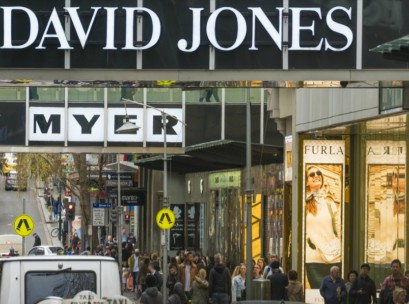 Late last week, department store chain David Jones reported weakened 1 per cent sales growth for the 26 weeks to December 23, as the holiday period had not brought the expected footfall through its doors.
Late last week, department store chain David Jones reported weakened 1 per cent sales growth for the 26 weeks to December 23, as the holiday period had not brought the expected footfall through its doors.
Its South-African parent company, Woolworths Holdings, said that the poor sales figures were “in line with the rest of the retail market leading up to Christmas”.
Indeed, several other retailers have announced reduced figures over the Christmas period, with Kmart having a downturn in sales over the holidays, Tiffany seeing comparable sales fall 4 per cent across the Asia-Pacific region, and outdoor retailer Kathmandu dropping its projections after a slow end to the year.
All eyes turn now to department-store rival Myer, which has yet to release a trading update for the period, and which, after a second strike at its annual general meeting, needs to show shareholders that chief executive John King’s turnaround plan has the goods.
Despite their differences, both David Jones and Myer have both committed to right-sizing their physical locations as a result of the more difficult trading conditions they find themselves under, with David Jones hinting that “further net space reductions to improve the productivity of the store portfolio are planned”.
Declining footfall is hard to bear
Jason Pallant, lecturer of marketing at Swinburne Business School and pillar lead for service innovation at CXI Research Group, noted that this decision was made as a result of the difficult placement of department stores in the modern retail environment.
“We’re ending up with either really massively sized formats trying to be the one-stop-shop, and almost competing on an Amazon-sized scale… and if you can’t provide that, I think you’re seeing smaller, niche format [stores] which are saying ‘We can’t do everything, but we’re just going to do this one little bit very well’,” Pallant told IRW.
“I think this is why we’re seeing department stores having a lot of challenges because they’re in that strange middle ground of trying to do so many different departments, but none of them really have a massive, all-encompassing range, yet they’re also not small enough to be a niche player.”
Obviously there are practical concerns, such as large retail spaces costing more to operate, as well as making declining footfall more difficult to bear, said Pallant, though cost-saving is generally the wrong way to go about downsizing.
“The retailers that are doing it just to save costs, or to cut down on rent and staffing… I think for them that’s where it’s a bit short-sighted,” Pallant said.
“It really comes down to why it is happening. Is it happening out of being forced to do it? Or because it is a deliberate strategy.”
You can have too much choice
However, there are advantages to smaller format stores, according to Pallant, who notes that customers are generally overwhelmed by an excess of choice and by presenting a narrower range, a retailer can make it easier for consumers to actually buy a product.
As well, one of the biggest advantages of smaller stores is the ability to be more flexible, and make it easier to revamp, move products around and change displays than in a larger, more traditional department store.
This approach can help to keep a store’s retail experience from growing stale to a consumer base which is increasingly calling for experiential retail.





